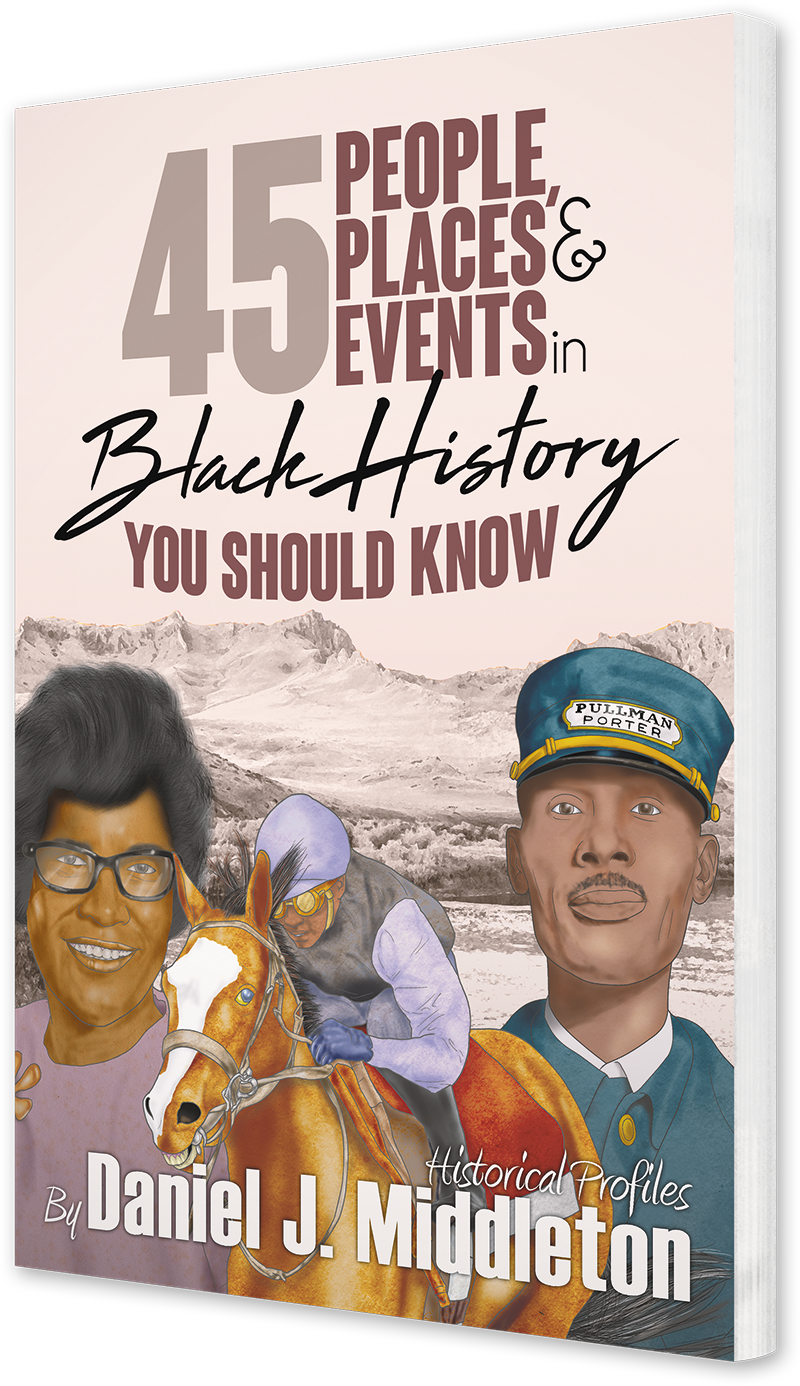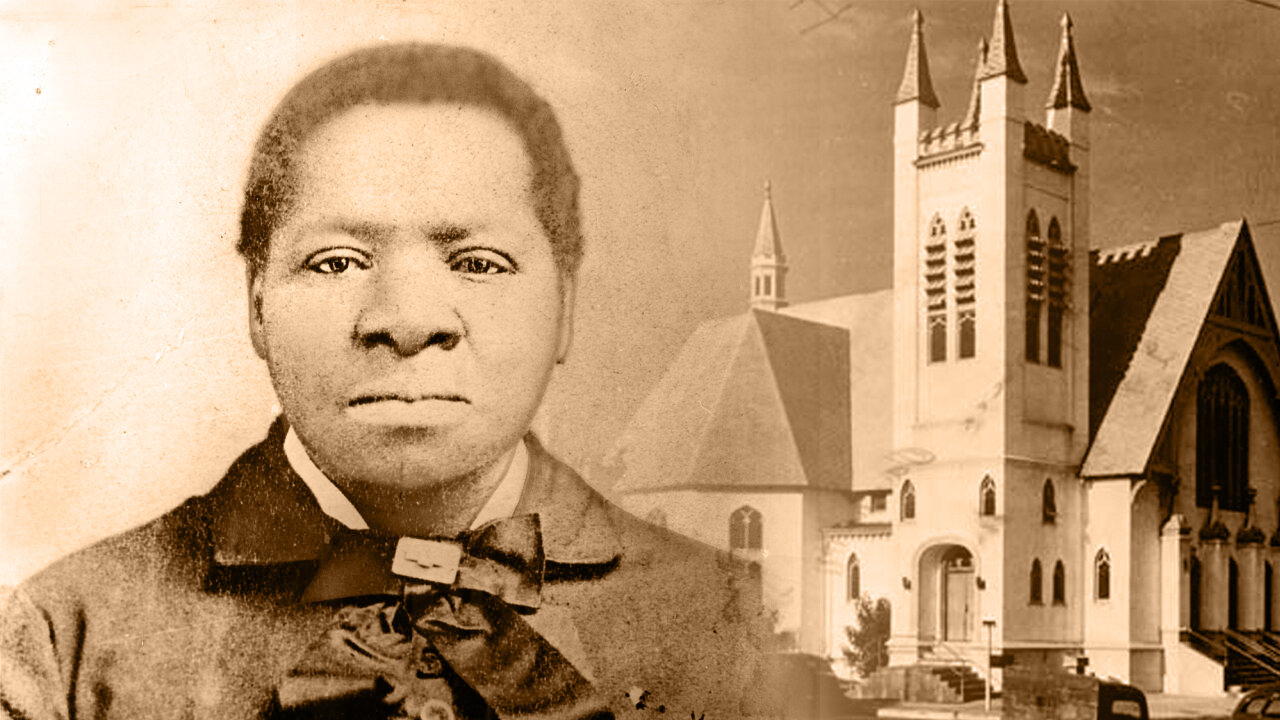Bridget “Biddy” Mason
The First Known Black Female Property Owner in Los Angeles
Composite portrait of Bridget “Biddy” Mason and the First African Methodist Episcopalian Church at the intersection of 8th and Towne in Los Angeles, California, circa 1940. Photos courtesy of Los Angeles Public Library and California State University Dominguez Hills.
Bridget “Biddy” Mason was brought to Los Angeles, California in 1851 as a slave. When she died, she was a free woman and the city’s wealthiest, having risen to the level of a black real estate tycoon worth multiple millions when accounting for inflation. She is noted as one of the first prominent Los Angeles landowners of the late-nineteenth century, and the founder of the First African Methodist Episcopal Church, which was established in 1872 in the city of Los Angeles.
Biddy was born into slavery on August 15, 1818—likely in Hancock County, Georgia. She was named Bridget but had no surname for many years. The nickname “Biddy” was bestowed by her first master. The record of her childhood has been lost, but it is believed she was sold to slaveholders in Mississippi as a baby. At age 18, Biddy was presented as a gift to a young newlywed couple in Mississippi, Robert and Rebecca Smith, whom she served as a nurse and midwife. While she lived on the Smith farm she cared for Rebecca, who was often sick, as well as her children. Biddy also worked the fields and tended to the livestock.
The Mormon Pioneer trail that stretched from Salt Lake Valley to San Bernardino, California. This image, dating to 1891, depicts the portion of the trail between Death Valley and Las Vegas. Courtesy of Frederick Monsen/Huntington Digital Library.
Around 1848, Robert Smith, who had converted to the Mormon faith and was lured by the promise of a New Zion on Earth, set out with his family and slaves on a long trek due West. He met up with a wagon caravan of Mormons along the way, and together, they wound a path through the rugged terrain of several states. Biddy, meanwhile—who had given birth to three daughters on the Smith farm—walked most of the way with her newborn, Harriet, strapped to her back. Her other two daughters, Ellen and Anne, were aged 10 and 4, Smith being the father of the two youngest ones, Anne and Harriet. Biddy continued to serve as a midwife to humans and animals alike along the 1700-mile trek, and she also set up camp, cooked, herded cattle, tended to the six Smith children in addition to her own, and broke camp when it was time to move on.
Following the seven-month journey, Robert Smith settled in the Salt Lake Valley—which was still a Mexican territory. There he resided for about three years before the desire for better land and prospects drew him to San Bernardino in a new U.S. state called California. He was warned by Mormon leader Brigham Young to avoid California, which was an anti-slavery state, but Smith forged ahead undaunted.
Biddy and her children were taken to San Bernardino, where Robert Smith settled after securing land along the Santa Ana River. The Mormons established a trading post and missionary church in San Bernardino while Smith entered the cattle business and did well for a time. But Biddy was making friends with black Southern Californians who had been freed from slavery, such as a couple named Charles and Elizabeth Rowan. They advised her to seek freedom on the grounds of California law. She also met wealthy black residents Robert and Winnie Owens. Robert owned a livery stable, and his son, Charles, began courting Biddy’s eldest daughter, Ellen.
What Biddy did not know was, under California law, she and her children were technically free the moment they crossed the border into the state. The California constitution stated:
“Neither slavery nor involuntary servitude unless for the punishment of crimes shall ever be tolerated in this state.”
Regardless of this, Biddy continued to serve Robert Smith, who lied to her about the conditions of her freedom. The death of Smith’s wife caused him to become disillusioned with the Mormon church, and he grew fearful of losing his slaves in California. In 1855, Smith took Biddy and her daughters, and his other slaves to Santa Monica Canyon, where they camped until he could make his way to the slave state of Texas. Elizabeth Rowan, who mistrusted Smith, contacted Los Angeles County Sheriff Frank Dewitt, alerting him to the danger Biddy and the other slaves were in. The Sheriff, accompanied by a posse, rode into Smith’s camp and served him with a writ of habeas corpus, thereby summoning him to appear in court for:
“persuading and enticing and seducing persons of color to go out of the state of California.”
Biddy, who by law was not allowed to testify against a white person, was given the privilege by U.S. District Judge Benjamin Hayes. With that, Biddy challenged Robert Smith in court for her freedom during a trial that was rife with bribery, attempted kidnapping, and threats of harm on the part of Smith and his supporters. But in the end, Judge Hayes ruled that:
“All of the said persons of color are entitled to their freedom and are free forever.”
As a result of that January 1856 ruling, 14 slaves won their freedom. Biddy and her daughters were finally allowed to live a life removed from slavery. They moved in with the Owens family, but shortly after, Anne, Biddy’s middle child, died—most likely of smallpox. But mourning eventually gave way to celebration when Charles and Ellen wed. Biddy was also able to use her skills when she was hired as a midwife and nurse by a white Southerner named Dr. John Strother Griffin. She was paid $2.50 per day, which was much higher than the average black woman was paid at the time. Biddy was able to save a considerable amount of money while delivering hundreds of babies and nursing patients during a smallpox epidemic in the mid-1860s.
With her savings, Biddy purchased land for $250 at 331 Spring Street, which is now in the heart of downtown Los Angeles. She built a small wood-frame house there and established the First AME Church in her new home. She also welcomed the needy. Los Angeles was not yet what it is today. In Biddy’s time, it existed as a dusty town with about 2,000 citizens, of which only 20 or so were black. Biddy came to be known by all of them, from the mayor down, as “Aunt Biddy.”
Book cover illustration of With Open Hands, by author Jeri Chase Ferris and artist Ralph L.Ramstad. The book is named for a motto Biddy often stated: “The open hand is blessed, for it gives in abundance, even as it receives.” Her black medicine bag is said to have held her medical instruments and the freedom papers she received from U.S. District Judge Benjamin Hayes.
Biddy eventually set up her own midwifery business, but both her former employer, Dr. Griffin, and her brother-in-law, Robert Owens, had invested in real estate. They encouraged Biddy to do the same. After buying the Spring Street land, Biddy invested in other properties. Biddy proved to be a savvy businesswoman, and her investments began to pay off. She bought land cheap, held onto the parcels for a few years, then sold the same parcels for considerable sums of money. Her Spring Street home was soon accompanied by boarding houses, shops, and other businesses, as Los Angeles transitioned from a dusty rural town to a bustling city.
By the mid-1880s, Biddy was living in an apartment on the second floor of a brick building she built, while the bottom half was a commercial rental. She helped members of her extended family purchase land around the city as well. Biddy also became a philanthropist as her wealth increased. She started a daycare, visited prisoners with baskets of food, donated to charities, and covered the salary of the AME minister as well as annual church taxes. When disaster struck in 1884, and homes were flooded by the Los Angeles River during a storm, Biddy kept an account at the Spring Street grocer for all affected homeowners, be they black or white. She was loved and appreciated by the citizens of Los Angeles, but after she died in 1891 at age 73, her legacy was largely forgotten and she was buried in an unmarked grave in Boyle Heights. This oversight was corrected nearly a century later by the mayor and officials of the AME church she founded, and her accomplishments and established legacy are now being honored by the current generation.
You may also be interested in:

This article appears in 45 People, Places, and Events in Black History You Should Know.
Available from Amazon.com, BN.com, and other retailers.






Freedom House Ambulance Service of Pittsburgh’s Hill District employed highly trained black paramedics who paved the way for modern EMS standards throughout the world.